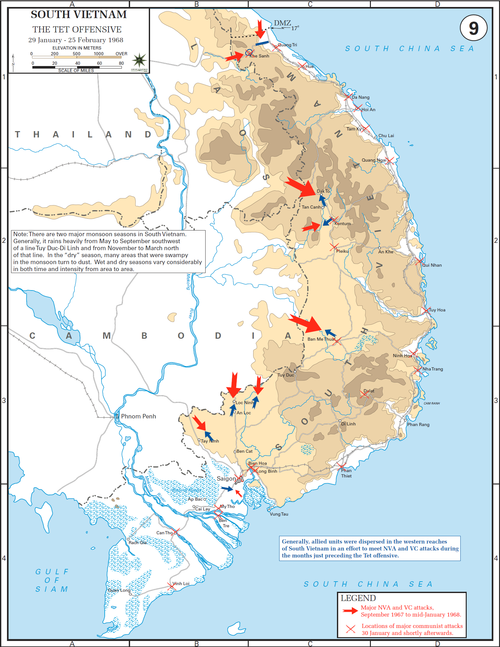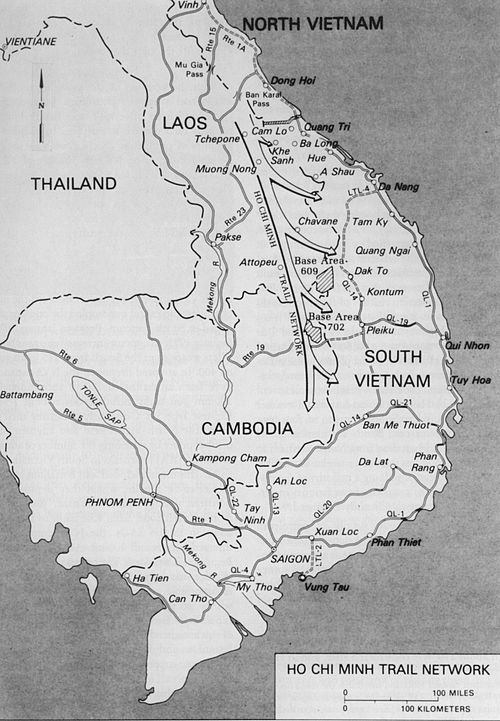OCR Specification focus:
‘The role of the US military in Vietnam, the Vietcong and guerrilla warfare; the Tet Offensive (1968); continuation of bombing campaigns’
The Vietnam War marked a turning point in Cold War history, where US military intervention, Vietcong tactics, and iconic battles such as the Tet Offensive reshaped global perceptions of conflict.
The Role of the US Military in Vietnam
The United States’ military presence in Vietnam expanded significantly from the mid-1960s, following President Lyndon B. Johnson’s Gulf of Tonkin Resolution in 1964. This provided near-unlimited authority to escalate US involvement. By 1968, over half a million American troops were stationed in Vietnam, engaged in direct combat.
Military Objectives and Strategies
The US military sought to:
Contain communism by preventing North Vietnam from unifying the country under communist rule.
Support South Vietnam militarily and politically to ensure its survival.
Employ strategies of attrition warfare, aiming to wear down the enemy through superior firepower and technology.
Key strategies included:
Search and destroy missions: Large sweeps of villages and jungles aimed at rooting out Vietcong fighters.
Air superiority: The use of helicopters for mobility, supply, and evacuation; extensive bombing campaigns.
Pacification programmes: Attempts to win “hearts and minds” of South Vietnamese civilians, often undermined by destruction caused by US operations.
Limitations of US Strategy
Despite technological advantages, the US military faced significant challenges:
Jungle terrain that nullified the effectiveness of heavy weaponry.
Civilian casualties from bombing and chemical defoliants (such as Agent Orange), which alienated the population.
Reliance on a South Vietnamese army (ARVN) that was often poorly trained, corrupt, or unmotivated.
The Vietcong and Guerrilla Warfare
The Vietcong (National Liberation Front) were communist insurgents fighting against the South Vietnamese government and US forces. Their methods posed serious problems for conventional American warfare.
Guerrilla Warfare: A style of irregular warfare involving ambushes, sabotage, hit-and-run tactics, and blending into civilian populations to avoid direct confrontation.
Vietcong Tactics
Tunnels: Extensive underground networks for shelter, movement, and storage of supplies.
Booby traps and mines: Caused disproportionate psychological and physical damage to US troops.
Ambushes and night raids: Created uncertainty and constant threat.
Political indoctrination: Gained support from rural peasants through propaganda and promises of reform.
The Vietcong’s tactics neutralised much of the US’s technological edge. Their ability to disappear into the countryside and re-emerge made it difficult to achieve decisive victories.
The Tet Offensive (1968)
The Tet Offensive was a coordinated attack launched in January 1968 during the Vietnamese New Year (Tet), when a ceasefire was expected.
Aims of the Offensive
Demoralise the US by showing that victory was far from near.
Spark uprising among South Vietnamese civilians against their government.
Demonstrate strength of North Vietnam and the Vietcong to international observers.
Events
Over 80,000 Vietcong and North Vietnamese troops attacked more than 100 towns and cities across South Vietnam, including Saigon and the US Embassy compound.

A clear, labelled map of the Tet Offensive (January–February 1968) indicating major attack axes and targeted urban centres. It visually reinforces the nationwide scope and simultaneous strikes that shocked US public opinion. Source
Although the offensive was militarily a failure (the Vietcong suffered heavy losses), it was a psychological and political victory.
Impact
In the US, media coverage of fierce fighting contradicted government claims that the war was being won.
Public opinion turned sharply against the war, fuelling anti-war protests and eroding support for Johnson’s administration.
The Vietcong’s resilience highlighted the limits of American military power.
Continuation of Bombing Campaigns
The US relied heavily on air power throughout the war.
Operation Rolling Thunder (1965–1968)
A sustained bombing campaign against North Vietnam intended to:
Destroy supply lines.
Undermine North Vietnamese morale.
Force concessions at peace talks.
However, it failed to achieve decisive results, as the North received significant supplies through the Ho Chi Minh Trail, which ran through Laos and Cambodia.

A network map of the Ho Chi Minh Trail indicating primary and secondary routes through Laos and Cambodia feeding forces into South Vietnam. It illustrates the redundancy and adaptability that blunted interdiction efforts. Source
Later Bombing Campaigns
After Tet, the US escalated aerial attacks:
Operation Linebacker (1972) and Operation Linebacker II (Christmas Bombing) aimed to cripple North Vietnam’s capacity and pressure it into negotiations.
These campaigns inflicted severe destruction but further inflamed global opposition to US conduct in Vietnam.
Consequences of Bombing
Limited military effectiveness due to North Vietnam’s determination and external support from the USSR and China.
High civilian casualties contributed to negative perceptions internationally.
Strengthened anti-war sentiment in the US, where the war was increasingly seen as unwinnable.
Conclusion of this Phase
By the end of the 1960s, the US military found itself in a war of attrition it could not decisively win. Despite immense military superiority, American forces were unable to overcome the Vietcong’s guerrilla warfare, the determination of North Vietnam, and the growing political backlash at home following the Tet Offensive and the continuation of devastating bombing campaigns.
FAQ
Helicopters were central to the American strategy of mobility. They allowed rapid troop deployment into difficult jungle terrain, quick evacuations of wounded soldiers, and supply drops to isolated units.
They also supported “search and destroy” missions, transporting troops directly into combat zones. However, reliance on helicopters made forces vulnerable to ambushes and anti-aircraft fire, limiting their effectiveness in sustained operations.
These missions often led to frustration and declining morale among US troops.
Villages destroyed during sweeps frequently reappeared as Vietcong bases weeks later.
Civilian casualties created ethical and psychological burdens on soldiers.
Many units nicknamed these operations “search and avoid”, reflecting a sense of futility.
Although US intelligence detected increased Vietcong activity before January 1968, commanders assumed attacks would focus only on border areas.
The use of the Tet holiday, traditionally a ceasefire period, enabled the North Vietnamese and Vietcong to mask preparations.
This miscalculation allowed large-scale coordinated assaults on urban centres, catching US and South Vietnamese forces off-guard.
The fighting in Huế was the longest and bloodiest of Tet.
North Vietnamese forces occupied most of the city, including the ancient citadel.
House-to-house combat lasted nearly a month, requiring extensive US and ARVN counterattacks.
The destruction of much of the city symbolised the brutality of the conflict and eroded South Vietnamese civilian confidence.
The expansion of bombing into Laos and Cambodia strained regional stability.
The Ho Chi Minh Trail ran through these countries, making them targets for heavy bombing.
Civilian casualties and devastation created political unrest, particularly in Cambodia, where resentment against the US contributed to the rise of the Khmer Rouge.
Laos became the most heavily bombed country per capita in history, despite officially being neutral.
Practice Questions
Question 1 (2 marks)
Name two tactics used by the Vietcong during the Vietnam War.
Mark scheme:
1 mark for each correct tactic identified (maximum 2).
Acceptable answers include:Use of tunnels
Booby traps/mines
Ambushes/night raids
Blending into the civilian population
Propaganda/political indoctrination
Question 2 (6 marks)
Explain how the Tet Offensive of 1968 affected the United States’ ability to continue the war in Vietnam.
Mark scheme:
1–2 marks: Simple description of events (e.g. “The Vietcong attacked many cities in South Vietnam and were eventually defeated”).
3–4 marks: Developed explanation with some link to US difficulties (e.g. “Although the Vietcong suffered heavy losses, the offensive showed they could strike anywhere, making Americans doubt victory”).
5–6 marks: Clear and detailed explanation of both military and political consequences (e.g. “The Tet Offensive undermined US claims of progress, shocked public opinion through media coverage of fighting in Saigon and Hue, and turned many Americans against the war, restricting Johnson’s ability to escalate further”).

